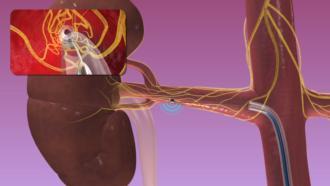
Medtronic has announced that it has received a Health Canada licence for its Symplicity Renal Denervation System to reduce treatment-resistant high blood pressure in patients unresponsive to three or more anti-hypertensive medications.
“Decreasing a patient’s systolic blood pressure from 160 to 130 mm Hg over a period of six months, which renal denervation has been shown to do, could prevent many heart attacks and strokes from ever happening,” said Barry Rubin, medical director, Peter Munk Cardiac Centre, Toronto, Ontario. “Our multidisciplinary renal denervation programme, which includes interventional radiologists, vascular surgeons, cardiologists, hypertension and kidney specialists will treat many eligible patients in the months ahead.”
Results from the SYMPLICITY HTN-1 trial have shown sustained safety and effectiveness of renal denervation with the system out to three years, and results from the SYMPLICITY HTN-2 trial showed safe, and statistically significant reduction of blood pressure (-33 mg Hg systolic blood pressure) at six months following the procedure and sustained to 12 months. These data were recently presented at the annual American College of Cardiology during an oral session, which was dedicated to renal denervation.
In addition to the licence from Health Canada, the Symplicity Renal Denervation System has received CE mark and a listing with Australia’s Therapeutic Goods Administration (TGA). The Symplicity Renal Denervation System is under investigational use in the United States.
About the Symplicity Renal Denervation System
The Symplicity Renal Denervation System accomplishes renal denervation via a minimally invasive procedure that disables sympathetic nerves located in the renal artery walls, which has been shown to reduce high blood pressure. The system consists of a generator and a flexible catheter. The catheter is introduced through the femoral artery in the upper thigh and is threaded up into the renal artery near each kidney. Once in place, the tip of the catheter delivers low-power radiofrequency energy according to a proprietary algorithm, or pattern, to ablate the surrounding sympathetic nerves. The procedure does not involve a permanent implant.













